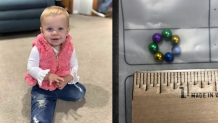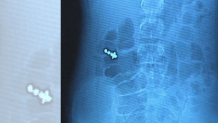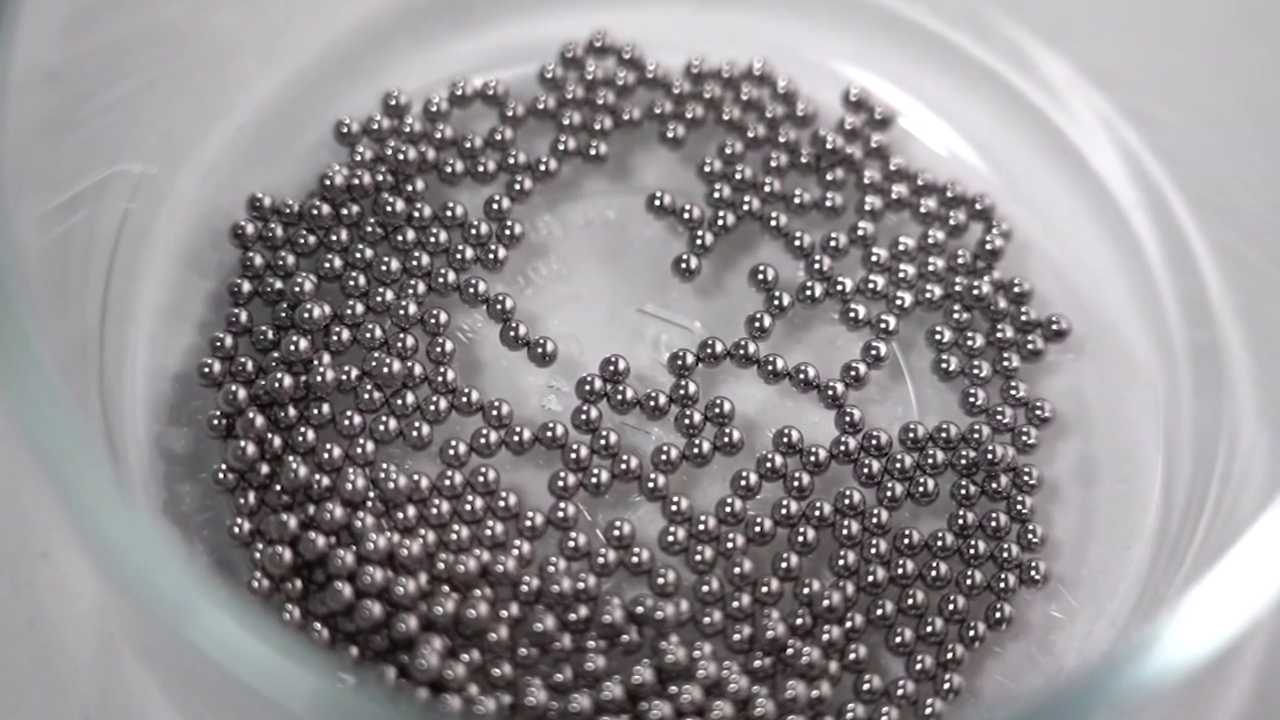On a winter evening inside a Michigan home hit hard by COVID-19 this past January, a toddler fell ill.
Her name was RayLynn.
While the 14-month-old RayLynn's symptoms mirrored that of the coronavirus, by the time doctors figured out what caused her to stop breathing, it was too late.
Her family would be left devastated and shocked by the coroner’s findings: RayLynn died after ingesting seven multicolored, high-powered magnetic beads that connected while inside her. The magnets were a Christmas present given to RayLynn’s older sibling.
Feeling out of the loop? We'll catch you up on the Chicago news you need to know. Sign up for the weekly Chicago Catch-Up newsletter here.
RayLynn’s death is one of three caused by small magnet ingestion since 2018 that NBC 5 Responds discovered after reviewing police reports, medical examiner findings and investigations conducted by the U.S. Consumer Product Safety Commission (CPSC) in the last four years.
The deaths did not occur in a vacuum.
Ever since a ban on selling high-powered tiny magnet sets was overturned in 2016, NBC 5 Responds found injuries caused by ingestion have risen by more than 530%.
While a proposed CPSC rule could reinstate that ban in the future, it will not be in place by the time families and caregivers head to online and retail stores this year looking for holiday gifts.
That’s why doctors and advocates fear the injuries and deaths -- some they’ve seen first-hand -- may not be the last, prompting a stern warning: Small magnet sets have no place in the homes of small children.
The consequences of such could be fatal.
"They look so innocent, but they’re deadly."
RayLynn’s parents allowed NBC 5 Responds to use their daughter’s name and photo in hopes that other parents and caregivers will take warnings over magnets seriously.
It started with a well-intentioned Christmas present for RayLynn’s older sibling last year. That gift — a set of multicolored 3mm magnetic balls — was the culprit that took the Michigan Center toddler’s life. According to a Blackman-Leoni Township Police investigation, the magnet set was a gift from a relative.
In the days leading up to RayLynn’s death on Jan. 5, 2021, the entire family was feeling the effects of COVID-19 after a family member had tested positive, and had been quarantining. RayLynn had not been eating or drinking and had vomited on numerous occasions.
Doctors had told the family they thought RayLynn should be tested for COVID-19, and her conditions should be monitored.
On Jan. 5, the situation took a dire turn. The toddler was rushed to a local hospital, but there was little doctors could do to save her life.

It wasn’t until after RayLynn’s death that the Jackson County Michigan Medical Examiner's office found her symptoms and death were not caused by the coronavirus, rather seven magnetic beads first discovered in an X-Ray. The Medical Examiner's office confirmed her cause of death as bowel perforation after the beads magnetized while inside her.
By the time RayLynn’s devastated family learned of the magnets, investigators said the product's packaging had already been thrown away, making it difficult to confirm the specific brand involved.
An officer collected the remaining magnets as evidence in the investigation.

RayLynn’s mother told a CPSC investigator months later that she believes the magnets were purchased online after a relative saw an advertisement on social media.
The reality is still difficult for RayLynn’s family to comprehend, that something so small could cause so much damage.
"You would never think it," RayLynn’s father Nathan told NBC 5 Responds. "They look so innocent, but they’re deadly."
Deaths In The Midst Of Nationwide Surge of Injuries
Injuries caused by magnet ingestion have become a terrifying norm for Pediatric Gastroenterologist Dr. James Berman.
Berman has no connection to the case out of Michigan but said the problems caused by magnet ingestion are not isolated to one place. They can be found nationwide.
Berman said he and his team of surgeons and specialists with the Chicagoland Children’s Health Alliance are now seeing a magnet ingestion case every other month, at least six a year.
"The strength of these is so powerful," Berman said, holding four magnets that recently threatened the life of a Chicago child. "These magnets definitely are associated with perforation of the intestines."
The doctor lists the symptoms of magnet ingestion so easily, it’s clear they’ve become routine for him.
"The child has pain. And then that pain progresses to more tenderness where you can’t push on their belly," Berman said. "Then they can develop a fever."
Symptoms, followed by an X-Ray and a telltale image.
"They're pretty recognizable on the X-ray because they're little round balls," Berman explains. "And there's more than one."

The fact that these magnets are often sold by the hundreds -- some sets even containing 1,000 -- and that they have a stronger flux index or strength, Berman said there's a high risk of injury if swallowed.
"One magnet is not a problem. They're small objects, and they can easily pass from one end to the other," Berman explains.
"The problem is that these magnets that are produced in these sets have a force that holds them together very tightly," Berman said. "If the magnets happen to get apart from each other and then reattach [internally], then one magnet ends up on one side of the wall of the intestines and one magnet ends up on the other side and they pinch."
No one wants to hear that their child's appendix perforated.
Dr. James Berman, Advocate Children’s Hospital
For all of the close calls doctors see, there is a growing list of victims who don’t make it, including RayLynn and two additional deaths NBC 5 Responds is reporting for the first time.
The deaths were uncovered after a Freedom of Information Act request for records from the U.S. Consumer Product Safety Commission.
A 2-year-old boy died in 2018 after swallowing 14 magnetic beads, a CPSC investigation found. The CPSC redacted all other identifiable details in its report, including where the death took place.
When it began its investigation a year later in 2019, CPSC investigators reported the boy’s symptoms included stomach pains and vomiting two days prior to his death.
In New York, the CPSC reports the rare case of a magnet ingestion death involving an adult.
A 43-year-old man died in 2020 after swallowing an unknown amount of magnetic beads from a building set. The circumstances leading to his death are unknown, as investigators reported a difficult time tracking down the man’s family and the autopsy findings from the New York City’s Office of Chief Medical Examiner, according to a letter included in the documents.
In all three deaths in the last three years, CPSC investigators could not determine the brands of magnets due to unique challenges in each circumstance. That conclusion is likely based in part on the fact that the market has been flooded by different magnet sets sold from across the globe.
While some magnet sets include extensive warnings, advocates believe a label only goes so far once the magnets enter a home and are out of the box.
New Regulation on Tiny Magnets
Heading into this holiday season, NBC 5 Responds found many magnet sets for sale, both online and in stores.
Some sets include labeling that the product is not for children, but can still be found on toy store shelves.
Nancy Cowles, executive director of the nonprofit Kids in Danger, believes there’s no reason these products should be on the market.
"There’s really no way to contain the danger," Cowles said.
Cowles and other advocates said there is reason to be optimistic for the future.
A newly proposed rule by the CPSC would reinstate a ban on tiny high-powered magnets, similar to one that was put in place back in 2014.
After reports of thousands of children injured by magnet ingestion, and at least one child that died, the CPSC in 2014 deemed toy magnets and games made from rare earth elements a safety risk and recalled them from the market.
Records from the CPSC show magnet ingestions decreased by nearly 80% in the months that followed.
But in 2016, a 10th Circuit Court of Appeals decision repealed the CPSC’s rule, finding it was “incomplete and inadequately explained.”
Soon after, magnets found their way back on store shelves and injuries from ingestions rose across the country.
Cowles said she knows that the CPSC's proposed rule will save lives, if passed.
"It will take these high powered magnets completely off of the market rather than just labeling them for older children," Cowles told NBC 5 Responds.
The only caveat is that there’s no way the new rule will be in place by this holiday season, and that’s why advocates urge anyone with small children inside the home to keep these small magnets completely out.
"Get it out of homes and keep children safe because obviously the children have no idea of the danger. And frankly, most parents have no idea of the danger," Cowles said.



